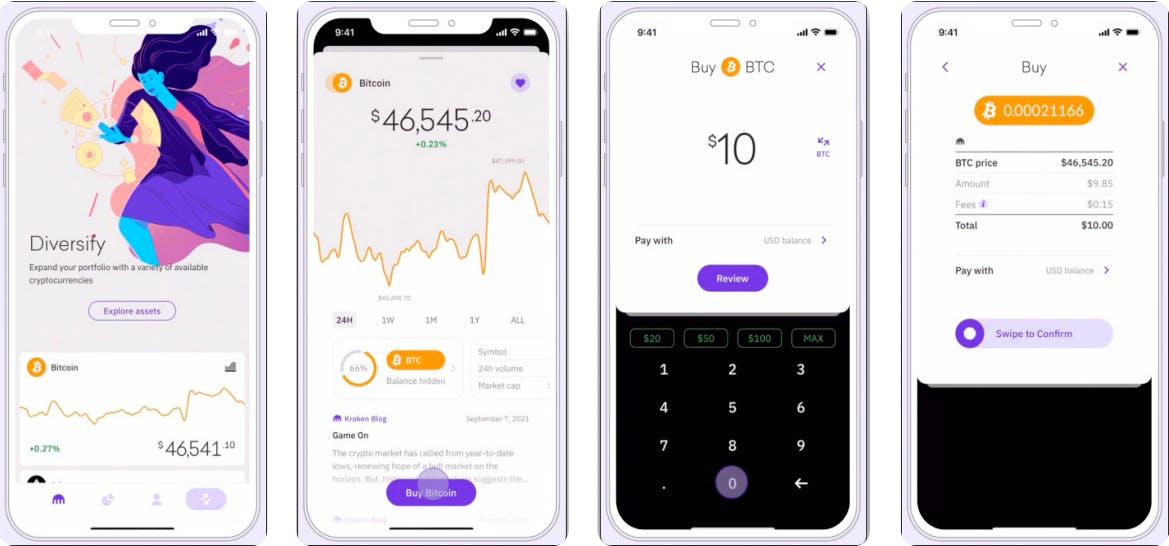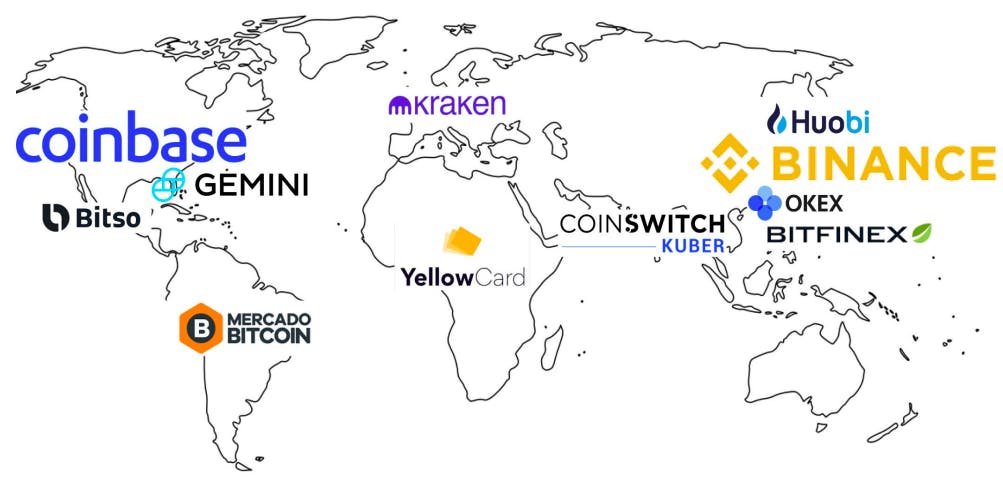
Revenue
$1.55B
2025
Valuation
$20.00B
2025
Funding
$832.00M
2025
Growth Rate (y/y)
128%
2024
Revenue
Sacra estimates that Kraken has generated $1.55B in revenue in the first nine months of 2025, exceeding its 2024 revenue total of $1.5B.
Q3'25 revenue was up 114% year-over-year over $303.5M in Q3'24 and 50% quarter-over-quarter from $432.2M in Q2'25.
Kraken primarily monetizes through transaction fees, with Q3'25 platform volume hitting $561.9B, up 106% year-over-year.
Funded accounts grew 46% year-over-year to 5.2 million, while assets on platform rose 89% YoY to $59.3 billion. Adjusted EBITDA came in at $178.6 million for the quarter—up 124% quarter-over-quarter.
Valuation & Funding
In November 2025, Kraken secured a $200 million strategic investment from Citadel Securities at a $20 billion valuation.
In September 2025, Kraken raised $600 million at a $15 billion valuation from investors including Jane Street, DRW, HSG, Oppenheimer, Tribe Capital, and the family office of Arjun Sethi.
Including these two rounds, Kraken’s total primary funding now stands at approximately $832 million, up from $27 million raised prior to 2025.
Product
Founded in 2011, Kraken launched its crypto exchange in 2013, finding product-market fit as the only place to buy and sell Bitcoin with euros—revenue grew from about $160M in 2017 to $2B in 2021 as total Bitcoin trading volume rose from $53B to $625B.
The exchange officially launched to the public in September 2013, initially offering trading for Bitcoin, Litecoin, euro, and US dollar.

Kraken's consumer experience on iOS enables users to buy from across 70+ cryptocurrencies with a minimum deposit of $10.

On the web, Kraken offers a fully-featured order book and trading interface that can be customized by the user.
Kraken positions itself as a secure and regulation-compliant exchange. It holds 95% of deposits in air-gapped, geo-distributed cold storage and has not faced any hacking/coin theft incidents since its launch. It is registered with key regulatory bodies such as FinCEN (US), FINTRAC (Canada), FCA (UK), and AUSTRAC (Australia). For comparison, Binance (largest crypto exchange by volume) doesn’t provide any details on customer deposit safety measures. It had a large-scale security breach in 2019, resulting in the theft of $40 million in Bitcoin.
Kraken acquired a Special Purpose Depository Institution Charter from the state of Wyoming in 2020, and as a result, plans to begin bank operations for digital assets in 2022. This is essential to Kraken’s vision of being the most trusted bridge between the crypto economy and the existing financial system—acquiring an SPDIC means that Kraken can offer new products such as custodial services, US dollar deposits, debit card, salary accounts, and stock trading.
The license does come with a few restrictions—most notably, that Kraken Bank becomes a ‘custody bank’ and cannot use its crypto deposits for lending. Also, it is required to hold reserves backing 100% of customer deposits in the form of US Treasury securities, corporate debt, and other investment-grade debt instruments.
The exchange serves over 9 million users across 190+ countries. While Europe remains Kraken's largest market, it has expanded significantly in North America and is growing in regions like Japan, Australia, and the UAE.
As of September 2025, Kraken expanded its product offering to include trading of over 60 tokenized US equities for EU clients, leveraging Backed Finance’s xStocks platform to enable blockchain-based certificates that track companies like Apple, Meta, and GameStop.
In October 2025, Kraken launched the Krak app—a global money platform built on public blockchains that enables instant transfers across 160+ countries via Kraktags, supports 300+ assets (fiat, crypto, stablecoins), and offers rewards including up to 4.1% APR on USDG and up to 10% on staked crypto, with Krak cards and collateral‑based lending coming soon.
Business Model
Kraken's core business model revolves around taking a percentage fee on each trade executed on its platform.
Fees vary by trading volume and account type, with professional and institutional clients paying reduced rates based on monthly volume tiers.
Kraken's average revenue per user is approximately $2,000 annually, consistent with a customer base skewing to higher-value traders relative to retail-focused competitors.
Kraken maintains a multi-collateral derivatives engine that lets users post various cryptocurrencies as margin to improve capital efficiency.
Staking services generate yield for users, and Kraken takes a percentage of rewards, creating recurring revenue streams beyond pure trading activity.
Cost drivers include technology infrastructure, regulatory compliance, customer acquisition, and liquidity provisioning. Kraken reported $424 million in adjusted EBITDA on $1.5 billion revenue in 2024.
Recent acquisitions, including NinjaTrader for $1.5 billion and Small Exchange for $100 million, extend coverage into regulated U.S. futures and retail trading platforms.
These moves add revenue streams that can use existing compliance and technology infrastructure.
Competition
Regulated incumbents

Coinbase has invested heavily in vertical integration, acquiring Deribit for $2.9 billion to add options trading and Echo for token issuance capabilities.
The public company maintains a compliance-first approach targeting institutional clients, though it lacks onshore U.S. futures offerings.
Gemini positions itself as the compliant European alternative with MiFID II licensing and USDC-settled perpetuals.
The platform focuses on regulatory arbitrage, offering institutional-grade services in jurisdictions where competitors face restrictions.
Traditional financial institutions including CME Group and Intercontinental Exchange continue expanding crypto offerings, leveraging existing regulatory relationships and institutional client bases to compete for professional trading flow.
In November 2025, SoFi launched SoFi Crypto, becoming the first nationally chartered bank in the US to offer consumer crypto trading.
Liquidity leaders
Binance remains the dominant global exchange with approximately 41% market share in spot trading and 30% in derivatives despite ongoing regulatory challenges.
The platform maintains near-zero fees on major Bitcoin pairs to retain retail flow, while offering comprehensive DeFi and financial services.
OKX holds the number two position in derivatives trading with sophisticated institutional products including spread trading and cross-currency arbitrage tools.
The platform claims 60% market share in spread trading and has processed over $10 billion in institutional volume through its Liquid Marketplace.
Bybit has emerged as a fast-growing retail-focused platform, reaching number two or three in derivatives with $14.9 billion in daily volume. The exchange offers zero-fee Bitcoin trading and aggressive VIP rebate programs to attract high-volume traders.
Specialized platforms
Deribit dominates crypto options trading with deep liquidity in Bitcoin and Ethereum contracts.
FTX's collapse created opportunities for specialized derivatives platforms to capture institutional flow seeking alternatives to general-purpose exchanges.
Decentralized exchanges like Uniswap and dYdX represent structural competition by eliminating custody requirements and reducing counterparty risk.
These platforms continue gaining market share, particularly for newer tokens and DeFi-native trading strategies.
TAM Expansion
Regulated derivatives
Kraken's acquisition of Small Exchange provides a CFTC-licensed derivatives clearing organization, enabling fully regulated futures and options in the U.S. market.
Combined with the NinjaTrader acquisition, this creates a coast-to-coast regulated derivatives infrastructure targeting the multi-trillion-dollar traditional derivatives market.
The company's MiCA license allows passporting of custody, trading, and payment services across all 30 European Economic Area states.
This regulatory foundation positions Kraken as a compliant alternative to offshore venues as institutional adoption accelerates.
Regulated derivatives represent less than 20% penetration of the broader crypto derivatives market, creating significant expansion opportunities as institutions require compliant venues for risk management and portfolio allocation.
Traditional assets
Kraken's xStocks product enables 24/7 trading of tokenized U.S. equities and ETFs through Solana-based wrappers for European clients.
The platform also launched commission-free trading of 11,000 U.S. stocks and ETFs for American users, expanding from the $1 trillion crypto market into the $55 trillion global equities market.
The integration of traditional and crypto assets on a single platform creates cross-selling opportunities and increases wallet share among existing clients.
Professional traders can hedge crypto positions with traditional assets while accessing extended trading hours unavailable on legacy exchanges.
Tokenized securities represent an emerging asset class that could bridge traditional finance and crypto markets, with Kraken positioned as an early mover in regulated tokenization infrastructure.
Embedded crypto trading
The company's white-label crypto-as-a-service offering through Kraken Embed allows neobanks and broker-dealers to add crypto trading capabilities.
Early partnerships include European neobank Bunq, demonstrating distribution potential without direct customer acquisition costs.
Banking services including payroll and treasury management for crypto-native companies represent additional revenue opportunities as the digital asset ecosystem matures and requires traditional financial infrastructure.
Risks
Regulatory crackdown: Crypto exchanges face evolving regulatory frameworks across major jurisdictions, with potential restrictions on derivatives trading, staking services, or cross-border operations. Regulatory changes could limit product offerings, increase compliance costs, or restrict access to key markets, with material impact on revenue and growth prospects.
Market concentration: The crypto exchange industry exhibits winner-take-all dynamics where liquidity attracts more liquidity, potentially allowing high-share exchanges like Binance to maintain market share despite regulatory challenges. Kraken's mid-tier position by volume could become unsustainable if institutional clients consolidate trading activity on fewer platforms.
Technology disruption: Decentralized exchanges and automated market makers continue gaining market share by eliminating custody requirements and reducing counterparty risk. If DeFi protocols achieve comparable liquidity and user experience to centralized exchanges, Kraken's business model, based on intermediating trades and holding customer assets, could face structural obsolescence.
News
DISCLAIMERS
This report is for information purposes only and is not to be used or considered as an offer or the solicitation of an offer to sell or to buy or subscribe for securities or other financial instruments. Nothing in this report constitutes investment, legal, accounting or tax advice or a representation that any investment or strategy is suitable or appropriate to your individual circumstances or otherwise constitutes a personal trade recommendation to you.
This research report has been prepared solely by Sacra and should not be considered a product of any person or entity that makes such report available, if any.
Information and opinions presented in the sections of the report were obtained or derived from sources Sacra believes are reliable, but Sacra makes no representation as to their accuracy or completeness. Past performance should not be taken as an indication or guarantee of future performance, and no representation or warranty, express or implied, is made regarding future performance. Information, opinions and estimates contained in this report reflect a determination at its original date of publication by Sacra and are subject to change without notice.
Sacra accepts no liability for loss arising from the use of the material presented in this report, except that this exclusion of liability does not apply to the extent that liability arises under specific statutes or regulations applicable to Sacra. Sacra may have issued, and may in the future issue, other reports that are inconsistent with, and reach different conclusions from, the information presented in this report. Those reports reflect different assumptions, views and analytical methods of the analysts who prepared them and Sacra is under no obligation to ensure that such other reports are brought to the attention of any recipient of this report.
All rights reserved. All material presented in this report, unless specifically indicated otherwise is under copyright to Sacra. Sacra reserves any and all intellectual property rights in the report. All trademarks, service marks and logos used in this report are trademarks or service marks or registered trademarks or service marks of Sacra. Any modification, copying, displaying, distributing, transmitting, publishing, licensing, creating derivative works from, or selling any report is strictly prohibited. None of the material, nor its content, nor any copy of it, may be altered in any way, transmitted to, copied or distributed to any other party, without the prior express written permission of Sacra. Any unauthorized duplication, redistribution or disclosure of this report will result in prosecution.